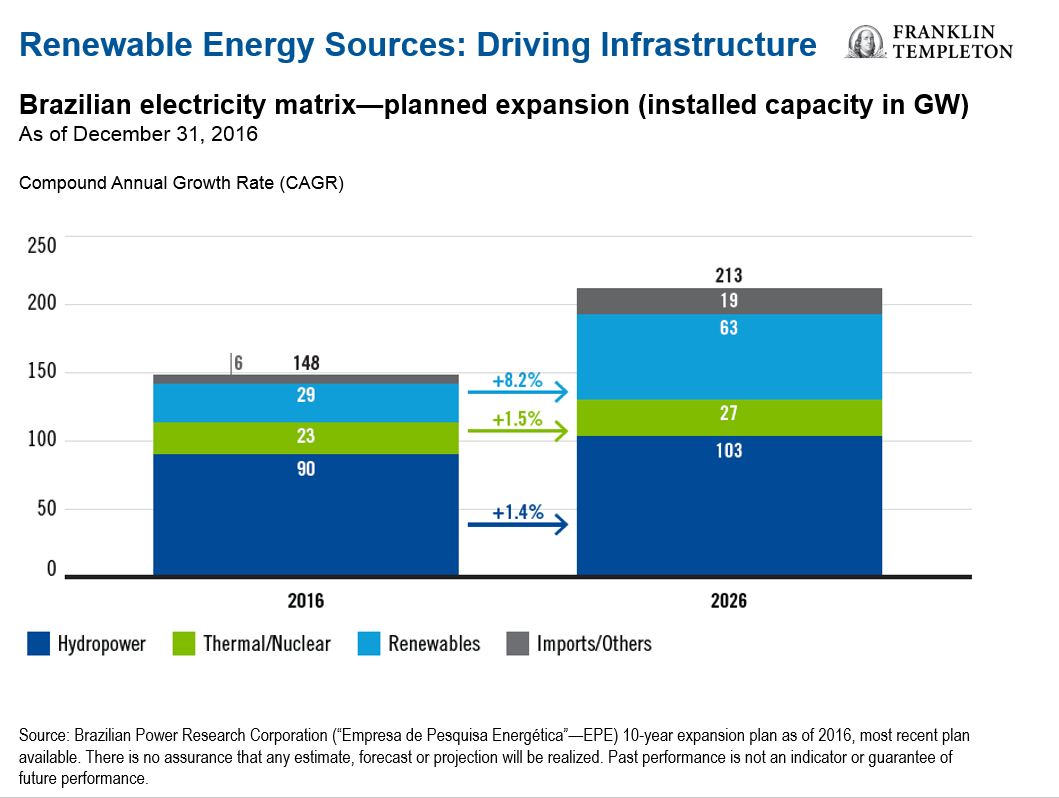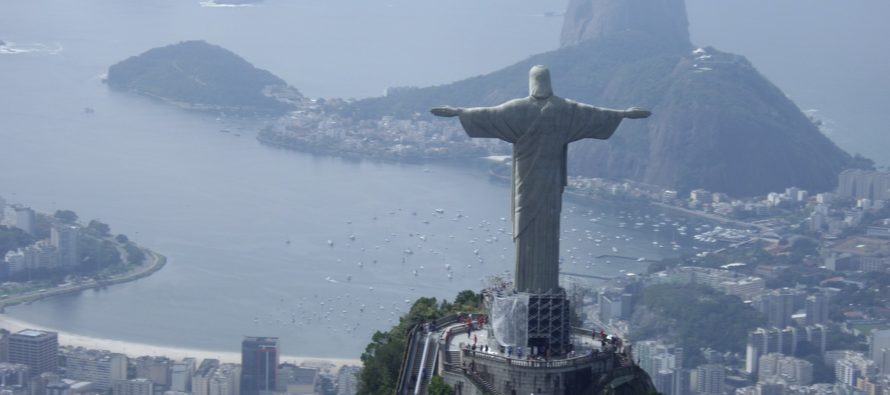The Winds of Change
Wind turbine technology thrives in Latin America
Climate concerns are driving change across Latin America, as countries embrace cleaner energy and look for more sustainable ways to increase power generation. Wind turbine technology—considered one of the cleanest sources of energy on the planet—is among those more sustainable ways.
From 2000 to 2017, global wind capacity increased from 17,000 megawatts to more than 500,000 megawatts, according to the International Renewable Energy Agency (IRENA). Latin America is at the forefront of this revolution. In fact, Brazil is the most advanced country in the region in terms of wind power utilization. As of 2017, the nation had 447 wind farms with an installed capacity of 11 gigawatts (GW)—enough to power more than 10 million homes.1
In addition, the country has committed to expand non-hydropower renewables, such as wind turbine technology, to at least 20% of total renewables by 2030. The Brazilian Energy Research Company expects more than 24 GW of wind power capacity to be added to the energy matrix by 2027.2

Investing Where the Wind Takes You
The opportunity for infrastructure investment in Latin America is robust
Significant resources in the way of capital will be needed as countries like Brazil look to build out their renewable energy infrastructure. According to Forbes magazine, 226 energy infrastructure-related investments in 2017 were financed by $61.8 billion of foreign capital, and this need for investment is expected to continue.3
The U.S. Energy Information Administration (EIA) suggests that power generation in the region will have to double by 2030 to support the growing population. The Economic Commission for Latin America and the Caribbean (ECLAC) estimates the population will rise from 625 million today, to 779 million by 2050, and it is estimated this increase will require investments greater than $700 billion.4 Renewable sources are expected to drive this expansion, particularly in Brazil, as the country reduces its dependence on large hydropower generation.
Locally, there are obstacles for this type of fund raising. As such, outside private-sector investors may be able to help fill this gap, but they must be able to recognize and address specific needs by project and country. Successful investment in the region’s infrastructure requires technical, financial and regulatory expertise. Companies participating in infrastructure projects can encounter a plethora of regulatory, political and financial hurdles that investors might have not experienced in other venues.
Broadly, however, the region may be an attractive target for foreign investors looking to develop renewable energy assets. Neighboring countries in the region have started developing regional power systems to connect electricity grids. This helps to alleviate the challenge of grid stability faced by intermittent energy sources like wind and solar. These grid enhancement projects present additional investment opportunities for private capital.

Catalyst for Energy Change
Wind is an ideal solution to hydropower disruption
The Brazilian government’s Alternative Energy Sources Incentives Program, although dormant for several years, served as a catalyst for the shift toward renewable energy in the region. The program offered independent power producers attractively priced and flexible 20-year power purchase agreements (PPAs) with the government majority-controlled entity Eletrobras. In addition, the largest development bank of Brazil, BNDES (Banco Nacional de Desenvolvimento Economico e Social), provided financing at low costs.5 As such, the segment has grown rapidly in the last 10 years.
In addition to government incentives, climate change has also served as a catalyst for wind technology. Between 2014 and 2017, Brazil faced some of the worst drought conditions in the country’s history. At one point in 2014, 17 of the nation’s 18 largest reservoirs were drained to a mere 1% of capacity—their lowest levels since record-keeping began. More than four million people were affected, and cities across the country were forced to impose water rationing. In São Paulo—the most populous city in South America and the worst hit by the crisis—water use was temporarily cut by as much as 40%.6
Obviously, the droughts significantly impacted the Brazilian economy and quality of life. However, the energy sector perhaps felt the most profound shock. This is because a significant source of power for Brazil—roughly 68%—has long been hydroelectricity. Given the water shortages, energy production was severely hampered. Blackouts and brownouts rolled across the country for weeks. High temperatures and increased air conditioning demand overwhelmed grids.
Clearly, the droughts caused substantial distress. It should come as no surprise that in a recent Pew Research Center survey of 26 countries, Brazil ranked global climate change as the topmost threat to national security.7
According to a World Bank study, it seems the worry is well placed. Despite its accounting for only 12.5% of global greenhouse gas emissions, if the Earth’s temperatures rise more than 2°C, Latin America will be one of the most-affected regions. For example, the melting of glaciers in the Peruvian and Bolivian Andes will likely accelerate.
In addition, as storms intensify, flash flooding will likely increase as well. In 2017, Peru and Columbia were pummeled by rains that led to catastrophic floods and mudslides, killing hundreds. In Peru alone, more than 240 bridges and thousands of miles of roads were destroyed. The reconstruction bill was estimated to be around $6 billion, more than 3% of the country’s GDP.
In short, climate risk is real risk, especially for Latin America. The region anticipates extreme weather events to become more frequent and intense due to global warming.
Wind energy is viewed as an ideal solution to supplement hydroelectric plants in the Latin American region. This is because even if there are no droughts, dry seasons still occur, which limits the generation of hydroelectric power. Renewables, like wind, round out hydro generation. It is during the dry season when wind energy production is usually the strongest.
The website Go-kite.com, the self-professed “preeminent kitesurf travel guide in the world,” proclaims the northeast coast of Brazil to be among the world’s best locations for kitesurfing. Because of the steady winds that blow up and down its eastern seaboard, the region is ideally suited for capturing wind power. It is not just the wind speed that is significant, it is the direction and the consistency as well. The vast majority of the year the winds blow onshore from the east, and generally the gusts are sustained but not excessive. There are likely a host of meteorological, environmental and geographic factors contributing to this dynamic, but the bottom line is these conditions are ideal for wind turbines seeking to wring power from the air.
The Perfect Storm for Green-Energy Development?
The opportunity for renewable infrastructure investment in Latin America, specifically in Brazil, appears significant. Demographic changes, government incentive plans and geographic factors have all dovetailed in recent years to create a sort of perfect storm for green energy development. Wind farms in particular are especially vital, as countries like Brazil look to mitigate their heavy reliance on hydropower with other sources of energy. Wind energy is an ideal solution to supplement hydroelectric plants, and more capital will be needed to develop green infrastructure facilities.
What Are the Risks?
All investments involve risks, including possible loss of principal. Stock prices fluctuate, sometimes rapidly and dramatically, due to factors affecting individual companies, particular industries or sectors, or general market conditions. Special risks are associated with foreign investing, including currency fluctuations, economic instability and political developments. Investments in emerging markets involve heightened risks related to the same factors, in addition to those associated with these markets’ smaller size and lesser liquidity.
Important Legal Information
This commentary reflects the analysis and opinions of the authors as of the date of this posting and may differ from the opinions of other portfolio managers, investment teams or platforms at Franklin Templeton Investments. Because market and economic conditions are subject to rapid change, the analysis and opinions provided are valid only as of the date of publication and may change without notice. Statements of fact are from sources considered reliable, but no representation or warranty is made as to their completeness or accuracy.
This material is intended to be of general interest only and should not be construed as individual investment advice or a recommendation or solicitation to buy, sell or hold any security or to adopt any investment strategy. It does not constitute legal or tax advice.
Data from third party sources may have been used in the preparation of this material and Franklin Templeton (“FT”) has not independently verified, validated or audited such data. FT accepts no liability whatsoever for any loss arising from use of this information and reliance upon the comments opinions and analyses in the material is at the sole discretion of the user.
_________________________________________________________
1. Source: Forbes, “Wind Investors Blow into Latin America,” July 14, 2017.
2. Source: Medium.com, “Brazilian government presents 10-year energy plan (PDE 2026),” July 19, 2017. There is no assurance that any estimate, forecast or projection will be realized.
3. Source: Forbes, “Wind Investors Blow Into Latin America,” July 14, 2017. There is no assurance that any estimate, forecast or projection will be realized.
4. Source: Economic Commission for Latin America and the Caribbean, February 2, 2016. There is no assurance that any estimate, forecast or projection will be realized.
5. Source: International Energy Agency.
6. Source: The Guardian, “Brazil’s worst drought in history prompts protests and blackouts,” January 23, 2015.
7. Source: Pew Research Center, “Climate Change Still Seen as the Top Global Threat but Cyberattacks a Rising Concern,” February 10, 2019.




